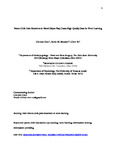Parent–Child Joint Behaviors in Novel Object Play Create High‐Quality Data for Word Learning
| dc.contributor.author | Chen, Chi-hsin | |
| dc.contributor.author | Houston, DM | |
| dc.contributor.author | Yu, C | |
| dc.date.accessioned | 2022-09-08T09:32:03Z | |
| dc.date.available | 2022-09-08T09:32:03Z | |
| dc.date.issued | 2021-09 | |
| dc.identifier.issn | 0009-3920 | |
| dc.identifier.issn | 1467-8624 | |
| dc.identifier.uri | http://hdl.handle.net/10026.1/19606 | |
| dc.description.abstract |
<jats:p>This research takes a dyadic approach to study early word learning and focuses on toddlers’ (<jats:italic>N</jats:italic> = 20, age: 17–23 months) <jats:italic>information seeking</jats:italic> and parents’ <jats:italic>information providing</jats:italic> behaviors and the ways the two are coupled in real‐time parent–child interactions. Using head‐mounted eye tracking, this study provides the first detailed comparison of children’s and their parents’ behavioral and attentional patterns in two free‐play contexts: one with novel objects with to‐be‐learned names (Learning condition) and the other with familiar objects with known names (Play condition). Children and parents in the Learning condition modified their individual and joint behaviors when encountering novel objects with to‐be‐learned names, which created clearer signals that reduced referential ambiguity and potentially facilitated word learning.</jats:p> | |
| dc.format.extent | 1889-1905 | |
| dc.format.medium | Print-Electronic | |
| dc.language | en | |
| dc.language.iso | eng | |
| dc.publisher | Wiley | |
| dc.subject | Attention | |
| dc.subject | Humans | |
| dc.subject | Infant | |
| dc.subject | Learning | |
| dc.subject | Parent-Child Relations | |
| dc.subject | Parents | |
| dc.subject | Verbal Learning | |
| dc.title | Parent–Child Joint Behaviors in Novel Object Play Create High‐Quality Data for Word Learning | |
| dc.type | journal-article | |
| dc.type | Journal Article | |
| dc.type | Research Support, N.I.H., Extramural | |
| plymouth.author-url | https://www.webofscience.com/api/gateway?GWVersion=2&SrcApp=PARTNER_APP&SrcAuth=LinksAMR&KeyUT=WOS:000692115300001&DestLinkType=FullRecord&DestApp=ALL_WOS&UsrCustomerID=11bb513d99f797142bcfeffcc58ea008 | |
| plymouth.issue | 5 | |
| plymouth.volume | 92 | |
| plymouth.publication-status | Published | |
| plymouth.journal | Child Development | |
| dc.identifier.doi | 10.1111/cdev.13620 | |
| plymouth.organisational-group | /Plymouth | |
| plymouth.organisational-group | /Plymouth/Faculty of Health | |
| plymouth.organisational-group | /Plymouth/Faculty of Health/School of Psychology | |
| plymouth.organisational-group | /Plymouth/Research Groups | |
| plymouth.organisational-group | /Plymouth/Research Groups/Plymouth Institute of Health and Care Research (PIHR) | |
| plymouth.organisational-group | /Plymouth/Users by role | |
| plymouth.organisational-group | /Plymouth/Users by role/Academics | |
| dc.publisher.place | United States | |
| dc.identifier.eissn | 1467-8624 | |
| dc.rights.embargoperiod | Not known | |
| rioxxterms.versionofrecord | 10.1111/cdev.13620 | |
| rioxxterms.licenseref.uri | http://www.rioxx.net/licenses/all-rights-reserved | |
| rioxxterms.type | Journal Article/Review |


